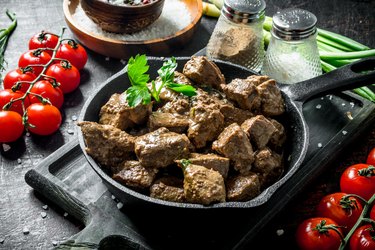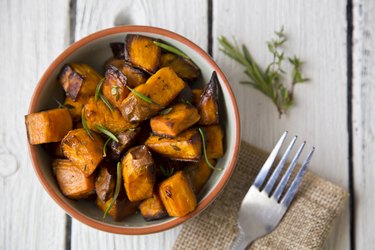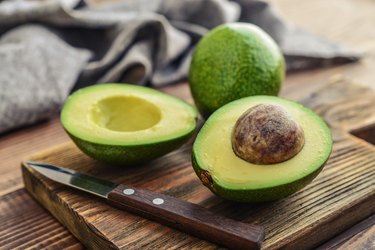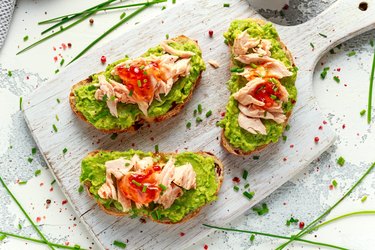Copper is good for more than pennies or pretty pots and pans. As an essential mineral, your body depends on copper to carry out basic life functions.
While copper is found in all body tissues, it's most well-known for its relationship with iron: Together, the two minerals help the body form red blood cells, which carry oxygen to cells and tissues. Copper also supports the health of your blood vessels, immune system, nerves and bones, according to the U.S. National Library of Medicine (NLM).
Video of the Day
Video of the Day
Copper is essential for survival, so it's a good thing it's found in so many foods. In fact, copper deficiency is rare in humans. While most people get enough copper, there are certain groups at risk for a deficiency, including those with celiac disease, Menkes disease and people who take high doses of zinc supplements, per the National Institute of Health (NIH).
Symptoms of copper deficiency include anemia, high cholesterol, osteoporosis and other bone disorders, lack of coordination, loss of skin pigment and an increased risk of infection.
How Much Copper Do You Need?
Copper is a trace essential mineral, which means you must get small amounts from food. The recommended amount for adults is 0.9 milligrams per day. People who are lactating or pregnant have an increased need of 1.3 milligrams per day.
Copper toxicity is rare but possible. Too much copper can cause liver damage and gastrointestinal symptoms such as cramping, diarrhea and vomiting.
But your diet is not the main culprit, so you don't have to worry about any high-copper foods to avoid. One of the most common causes of copper toxicity is contaminated water. Copper can get into drinking water through the acidic corrosion of copper pipes, per the Centers for Disease Control and Prevention (CDC).
Check out the list below for healthy foods with copper. Note that the FDA calculates its Daily Value (DV) percentages based on eating 0.9 milligrams of copper per day.
1. Liver: 1,313% DV

Liver is low in calories and high in essential vitamins and minerals. Just one slice of the organ meat provides 11.8 milligrams or 1,313 percent of the DV of copper and over 100 percent of several B vitamins as well as vitamin A.
With 704 percent of your DV of vitamin A, eating too much liver over time could lead to vitamin A toxicity. The NIH explains that excess preformed vitamin A (the type of vitamin A found in animal products) can have significant toxicity, known as hypervitaminosis A.
2. Oysters: 266% DV
Apparently, oysters aren't just for setting the date-night mood. Six cooked oysters contain 2.4 milligrams or 266 percent of the DV of copper.
While there's not much evidence to support the aphrodisiac effect of oysters, they have an impressive nutrient profile: They're low in calories, fat and carbs as well as high in protein; they are also a good source of iron, zinc and vitamin B12.
3. Lobster: 146% DV
A 3-ounce portion of cooked lobster will give you 1.3 milligrams or 146 percent of the DV for copper. You'll also get 113 percewnt DV for selenium, a bunch of B vitamins and over 16 grams of protein.
4. Shiitake Mushrooms: 144% DV
Shiitake mushrooms' umami flavor and meaty texture are perfect for plant-based dishes. Low in calories and high in minerals, 1 cup of cooked shiitake mushrooms contains 1.3 milligrams or 144 percent of the DV of copper. Shiitakes are also a good source of zinc and pantothenic acid.
Shiitake mushrooms contain a particular sugar called lentinan that has been found to slow tumor growth in certain cancers, according to the Memorial Sloan Kettering Cancer Center. More studies are needed to determine if the amount of lentinan in shiitakes provides the same benefit as the sugar itself.
5. Tofu: 106% DV
Tofu is an excellent meat substitute for a plant-based diet. One cup of tofu provides as much protein as seven eggs, and it's a great source of fiber and iron. Tofu isn't skimping when it comes to copper either: 1 cup of firm tofu has 1 milligram or 106 percent of the DV.
If you're stuck on what to do with it, try these high-protein tofu recipes. Plus, you won't have to worry about disinfecting your entire kitchen after making it (looking at you, meat).
6. Sweet Potatoes: 79% DV

Move over green bean casserole, sweet potatoes are taking the spotlight. A 1-cup serving of mashed sweet potatoes contains 0.7 milligrams or 79 percent DV of copper.
Sweet potatoes' signature orange color comes with a healthy dose of beta-carotene, which is a precursor to vitamin A. Beta-carotene helps your eyes to adjust to dim lighting and supports overall eye health, according to the Harvard T.H. Chan School of Public Health.
7. Cashews: 70% DV
In 1 ounce of cashews, you'll get heart-healthy fats, magnesium, zinc and 0.6 milligrams or 70 percent of your DV of copper.
Cashews are a nutrient-dense snack that can support heart health, but you don't have to just nosh on them plain. Enjoy cashews in vegan cheeses, granola and as cashew butter for a decadent alternative to peanut butter.
Other nuts high in copper include pistachios (44 percent DV per ounce) and almonds (33 percent DV per ounce).
8. Chickpeas: 64% DV
Garbanzo beans, aka chickpeas, are a plant-based nutritional powerhouse high in fiber, protein, iron and folate. You'll also get 0.6 milligrams or 64 percent DV of copper in 1 cup of cooked chickpeas.
Garbanzo beans are the traditional base for hummus, which makes it easy to get your daily dose. You'll also want to try the legume in these high-protein chickpea recipes.
9. Dark Chocolate: 56% DV
As if you needed another reason to love dark chocolate. One ounce of 70 to 85 percent dark chocolate contains 0.5 milligrams or 56 percent DV of copper. Plus, dark chocolate is a good source of iron and magnesium.
Magnesium is essential in over 300 metabolic processes in your body. According to Oregon Status University's Linus Pauling Institute, about half of American adults don't get enough magnesium.
10. Sunflower Seeds: 56% DV
Whether you spit the shells or opt for a bag of just kernels, sunflower seeds are a great source of copper and other important nutrients. One ounce of dry-roasted sunflower seeds has 0.5 milligrams or 56 percent DV of copper.
Sunflower seeds are also a great source of vitamin E, a fat-soluble vitamin with antioxidant properties. You can get vitamin E from supplements, but they may not offer the same benefits as the antioxidants that are found naturally in food, per the Mayo Clinic.
Other seeds high in copper include flaxseeds (38 percent DV per ounce) and chia seeds (29 percent DV per ounce)
11. Avocados: 42% DV

Avocados top the list of fruits high in copper (other copper-rich fruits include durian, guava, pomegranate and mango) with 0.4 milligrams or 42 percent DV of copper in one avocado.
High in unsaturated fats and fiber, avocados are nutrient-dense and can help you to feel full and satisfied after a meal. Try it in these creative avocado recipes that aren't toast or guac.
- National Library of Medicine: "Copper in Diets"
- National Institute of Health: "Copper"
- Centers for Disease Control and Prevention: "Copper and Drinking Water From Private Wells"
- U.S Food and Drug Administration: "Daily Value on the New Nutrition and Supplement Facts Labels"
- My Food Data
- National Institute of health: "Vitamin A"
- Memorial Sloan Kettering Cancer Center: "Shiitake Mushroom"
- Harvard T.H. Chan School of Public Health: "Vitamin A"
- Oregon Status University's Linus Pauling Institute: "Magnesium"
- Mayo Clinic: "Vitamin E"


